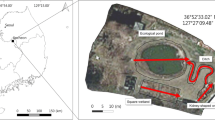Abstract
We estimated the pre-settlement density and area of different classes of palustrine wetlands on the Des Moines Lobe based on soil characteristics. Six wetland classes, ranging from temporarily flooded to permanently flooded, were identified based on soil properties that persisted after artificial drainage. Prior to drainage, wetlands covered nearly half of the Des Moines Lobe and there were differences in both the types and relative abundance of wetlands among the four geologic subdivisions of the Lobe (Bemis, Altamont, and Algona till plains and Altamont Lake). In the flat Altamont Lake zone, the most common wetlands were equally split between temporarily flooded and saturated water regimes. Among the three till plain zones, saturated wetlands were the dominant wetland type. Differences in wetland distributions among the zones probably derive from differences in initial topography and post-glacial processes such as erosion-deposition processes and stream-network formation.
Similar content being viewed by others
Literature Cited
Bishop, R. A. 1981. Iowa’s wetlands. Proceedings of the Iowa Academy of Science 88:11–16.
Bishop, R. A., J. Joens, and J. Zohrer. 1998. Iowa’s wetlands, present and future with a focus on prairie potholes. Journal of the Iowa Academy of Science 105:89–93.
Bishop, R. A. and A. G. van der Valk. 1982. Wetlands. p. 208–229.In T. C. Cooper (ed.) Iowa’s Natural Heritage. Iowa Natural Heritage Foundation and Iowa Academy of Science, Des Moines, IA, USA.
Burras, C. L. and W. H. Scholtes. 1987. Basin properties and postglacial erosion rates of minor moraines in Iowa. Soil Science Society of America Journal 51:1541–47.
Cowardin, L. M., V. Carter, F. C. Golet, and E. T. LaRoe. 1979. Classification of wetlands and deepwater habitats of the United States. U.S. Department of Interior, Fish and Wildlife Service, Office of Biological Services, Washington DC, USA. FWS/ OBS-79/31.
Galatowitsch, S. M. and A. G. van der Valk. 1994. Restoring Prairie Wetlands: An Ecological Approach. Iowa State University Press, Ames, IA, USA.
Galatowitsch, S. M., A. G. van der Valk, and R. A. Budelsky. 1998. Decision-making for prairie wetland restorations. Great Plains Research 8:137–55.
Gwynne, C. S. 1942. Swell and swale pattern of the Mankato Lobe of the Wisconsin drift plain in Iowa. Journal of Geology 50:200–08.
Iowa Geological Survey, Department of Natural Resources. 1995. The Des Moines Lobe and its glacial advances in Iowa. [Online] Available: http://www.igsb.uiowa.edu/nrgislibx/.
Iowa State University GIS Facility. 2008. Color Infrared Digital Orthophotos Quads, taken March-May 2002. [Online] Available: http://ortho.gis.iastate.edu/.
Johnson, W. C., B. V. Millett, T. Gilmanov, R. A. Voldseth, G. L. Gunterspergen, and D. E. Naugle. 2005. Vulnerability of northern prairie wetlands to climate change. BioScience 55:863–72.
Kemmis, T. J., G. R. Hallberg, and A. J. Lutenegger. 1981. Depositional environments of glacial sediments and landforms on the Des Moines Lobe, Iowa. Iowa Geological Survey Guidebook Series Number 6.
Khan, F. A. and T. E. Fenton. 1994. Saturated zones and soil morphology in a mollisol catena of central Iowa. Soil Science Society of America Journal 58:1457–64.
Ojakangas, R. W. and C. L. Matsch. 1982. Minnesota’s Geology. University of Minnesota Press, Minneapolis, MN, USA.
Quade, D. J., J. D. Giglierano, E. A. Bettis, and R. J. Wisner. 2002. Surficial geologic map of the Des Moines lobe of Iowa. Iowa Geological Survey. Open File Map, 2002–3.
Ruhe, R. V. 1969. Quaternary landscapes in Iowa. Iowa State University Press, Ames, IA, USA.
Soil Survey Division Staff, Natural Resources Conservation Service, United States Department of Agriculture. 1993. Soil survey manual. Soil Conservation Service. U.S. Department of Agriculture Handbook 18.
Soil Survey Staff, Natural Resources Conservation Service, United States Department of Agriculture. 2008-1. Soil Survey Geographic (SSURGO) Database. [Online] Available: http:// soildatamart.nrcs.usda.gov.
Soil Survey Staff, Natural Resources Conservation Service, United States Department of Agriculture. 2008-2. Official Soil Series Descriptions (OSD). [Online] Available: http://soils.usda. gov/technical/classification/osd/.
Stewart, R. A., D. Bryant, and M. J. Sweat. 1988. Nature and origin of corrugated ground moraine of the Des Moines Lobe, Story County, Iowa. Geomorphology 1:111–30.
Stewart, R. E. and H. A. Kantrud. 1971. Classification of natural ponds and lakes in the glaciated prairie region. U.S. Fish and Wildlife Service. Research Publication 92.
USACE (United States Army Corp of Engineers). 1987. Corps of Engineers wetlands delineating manual. Department of the Army Waterways Experiment Station, Vicksburg, MS, USA.
van der Valk, A. G. 2005. Prairie potholes of North America. p. 415–45.In P. A. Keddy and L. H. Fraser (eds.) The World’s Largest Wetlands: Their Ecology and Conservation. Cambridge University Press, Cambridge, UK.
Vepraskas, M. J. 1994. Redoximorphic features for identifying aquic conditions. North Carolina Agricultural Research Service. Technical Bulletin 301. North Carolina State University, Raleigh, NC, USA.
Vepraskas, M. J. and S. P. Faulkner 2001. Redox chemistry of hydric soils. p. 85–105.In J. L. Richardson and M. J. Vepraskas (eds.) Wetland Soils: Their Genesis, Hydrology, Landscape and Separation into Hydric and Nonhydric Soils. CRC Press, Boca Raton, FL, USA.
Wangpakapattanawong, P. 1996. Extent of historical wetlands of the prairie pothole region, north central Iowa. M.S. thesis. Iowa State University, Ames, IA, USA.
Author information
Authors and Affiliations
Corresponding author
Rights and permissions
About this article
Cite this article
Miller, B.A., Crumpton, W.G. & van der Valk, A.G. Spatial distribution of historical wetland classes on the Des Moines Lobe, Iowa. Wetlands 29, 1146–1152 (2009). https://doi.org/10.1672/08-158.1
Received:
Revised:
Issue Date:
DOI: https://doi.org/10.1672/08-158.1




